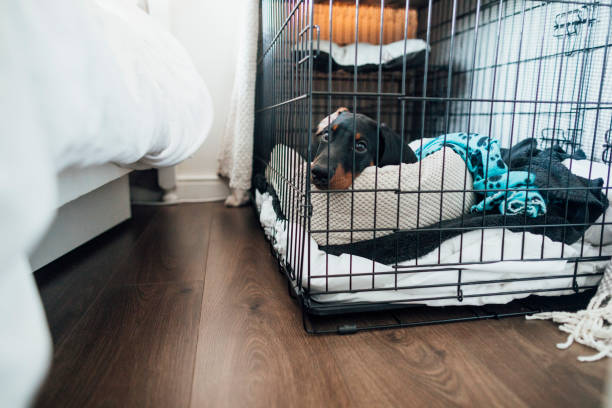
Crate training is a valuable tool for dog owners seeking to instill discipline and create a safe space for their furry companions. When done correctly, it can be a positive experience for both the dog and the owner. However, there are essential do’s and don’ts to consider to ensure that crate training is effective and humane.
Choose the Right Crate: The first step in crate training is selecting the appropriate crate size. It should be large enough for your dog to stand up, turn around, and lie down comfortably. If you have a puppy, consider a crate with an adjustable divider to accommodate their growth.
Introduce Gradually: Begin the process by introducing your dog to the crate gradually. Leave the crate open and allow your dog to explore it at their own pace. Place treats and toys inside to make it a positive experience.
Create a Positive Association: Make the crate a pleasant place for your dog. Feed them near the crate, and use treats or toys to reward them when they enter voluntarily. This helps build a positive association with the crate.
Use a Command: Teach your dog a specific command like “crate” or “kennel” to signal it’s time to enter the crate. Consistency in using this command helps your dog understand what you expect.
Keep it Comfortable: Add comfortable bedding or blankets to the crate to make it cozy. Many dogs prefer a soft surface to lie on. Make sure it’s clean and wash bedding regularly.
Limit Time Inside: Avoid leaving your dog in the crate for extended periods. Puppies, in particular, have limited bladder control and should not be crated for more than a few hours at a time. For adult dogs, aim for a maximum of 4-6 hours.
Don’t Use it for Punishment: Never use the crate as a form of punishment. Your dog should see it as a positive space, not a place for discipline.
Don’t Rush the Process: Crate training takes time. Rushing it can lead to anxiety and aversion. Be patient and allow your dog to adjust at their own pace.
Don’t Leave for Too Long: Avoid leaving your dog crated for excessive periods. They need regular breaks for exercise, socialization, and bathroom breaks.
Don’t Overuse: While crate training can be valuable, don’t overuse it. Your dog should spend quality time outside of the crate to interact with you and the environment.
Don’t Force Them In: Never force your dog into the crate. This can create fear and resistance. Instead, use positive reinforcement to encourage them to enter willingly.
Don’t Neglect Exercise: Ensure your dog gets enough exercise and mental stimulation. A tired dog is more likely to settle down in the crate without excessive whining or restlessness.
Skipping Gradual Introduction: Some owners try to crate their dogs immediately, leading to resistance and anxiety. Gradual introduction is key.
Inconsistent Use: Inconsistency in using the crate command or allowing the dog to come and go as they please can confuse your pet.
Ignoring Signs of Distress: If your dog shows signs of distress in the crate, like excessive whining, barking, or attempts to escape, do not ignore them. This could be a sign that something is wrong.
Leaving in Crate Too Long: Leaving your dog in the crate for extended periods without breaks can lead to accidents and discomfort.
Crate training can be a valuable tool for dog owners when done correctly. It provides a safe and comfortable space for your pet while helping with house training and providing structure. Remember to follow the dos and don’ts, be patient, and always prioritize your dog’s well-being. A well-trained and happy dog is the ultimate goal of crate training. Contact Giving a Dog a Bone today if you in need of true dog training help.